Tracing the importance of Trace minerals
Published: May 14, 2015
By: Dr. Anandha Narayanan Shanmugam (Natural Remedies Pvt. Ltd)
Costly products are always special for mankind like silver, gold, platinum, diamond and so on. Interestingly, there are still more metals costlier than this. Californium is considered to be the costliest metal which will cost you a Rs. 166 Crore/ gram. But their use for everyday thriving is almost nil. Minerals need not to be costly to give a better health every day. Costly for mankind is the product’s benefits. Minerals are both heroes and villains for a living being and with livestock, it is still a tougher challenge to praise the minerals as heroes and to avoid as villains.

Nutrients becomes indispensable for life. Carbohydrates, fats, minerals, proteins, vitamins and water as major nutrients are required for the regular functioning of animal system while anti-oxidants and phytochemicals becomes the micro nutrients which will involve in the protection and functioning of some body systems.
Though vitamins, minerals and water do not provide energy, they are required for multi-various functions of the body. Vitamins supplementation with ruminants is helped to a great extent by the micro flora especially B-complex vitamins. The critical part remains with the minerals. Its’ supplementation becomes essential as feed or supplements as such for a livestock to deliver its’ best.

Major dietary elements includes calcium, phosphorous, potassium, sulphur, chlorine and magnesium which will be required in a substantial volume and so their functional roles are clearly visible to a greater extent. Whereas, trace minerals which are required in lesser quantities will project its’ role minimally i.e. sub-clinically and so requires more attention to prevent this.
The biggest challenge is that minerals broadly classified as macro minerals which are required more than 200mg/day, micro minerals or trace minerals should be differentiated from another group of minerals, “toxic minerals”.
Seven major dietary elements are required for an animal (in order of abundance); calcium, phosphorous, potassium, sulphur, sodium, chlorine and magnesium. There are some trace or micro minerals required which includes, iron, cobalt, copper, zinc, manganese, molybdenum, iodine, bromide and selenium.
Entry into the body:
Minerals in soil gets absorbed by the plants/grass and most chemical elements will be in simple form and larger chemical compound elements need to be broken down for absorption and so the type of soil and the feed plays a vital role in determining the mineral supplementation of any livestock in that particular area. Animals with the habit of geophagia are more likely to receive a good quantity of minerals whereas modern day dairy farming had closed the gates for animals to be raised by intensive system of rearing where they hardly have access to soil and so minerals.
A good friend of animals, the gut bacteria are grabbing attention in feeding the animals with minerals properly. Gut bacteria provides Vitamin B12 which is very much helpful in the consumption of cobalt and these type of minerals are even called as bio minerals.
Trace minerals & toxic minerals becomes the usual keys to be manipulated with an animal which is non-productive.
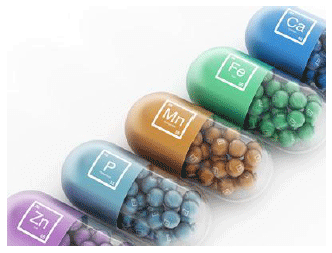
Chromium:
- Chromium was first shown to be essential for normal glucose utilization in rats.
- Chromium appears to have a role in glucose tolerance, possibly forming a complex between insulin and its receptors. Chromium is a component of glucose tolerance factor (GTF)
- Chromium may also play a role in lipid synthesis.
Molybdenum:
From the Greek word for lead, molybdos since it resembles lead.
Molybdenum is highly recognized as a toxic mineral than its essentiality. Teart is a famous disease that is closely associated with molybdenum toxicity which is a severe condition found in many areas of England which was due to high molybdenum toxicity in the grazing forage.
Considering this, molybdenum cannot be neglected as in early times since it can produce toxicity. Molybdenum is highly essential for many activities associated with the activation of enzymes like xanthine oxidase, aldehyde oxidase which are playing an important role in purine and pyrimidine metabolism.
Molybdenum and copper are highly interactive due to mineral antagonism where increase in copper supplementation decreases molybdenum utilization and vice versa. Sulphite also plays its part by decreasing molybdenum level in blood and increases its excretion via urine.
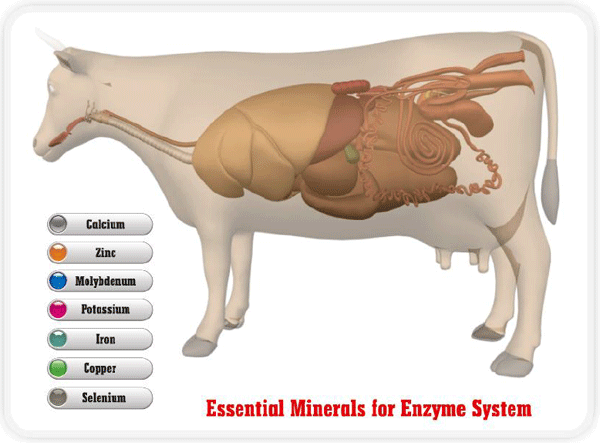
Copper:
From the Latin word cuprum, which means "from the island of Cyprus."
Copper supplementation was identified as essential since 1930s where a herd of cattle suffered from copper deficiency in U.K & U.S and an antagonism was found with molybdenum which caused the deficiency which is due to molybdenum toxicity in the forages. Further reports says that there is a three way interaction of copper, molybdenum and sulphur, where these three minerals will be forming an insoluble complex called as cupric tetra thiomolybdate in rumen by bacterial action to make copper will be unavailable.
Copper is available from some feeds and fodders based on the soil geology. Animals fed with fish meal, liver meal will be containing good source of Copper.
Copper is essential for the activation of several metalloenzymes like cytochrome oxidase, superoxide dismutase, tyrosinase and dopamine B- hydroxylase which are involved in cell multiplication, respiration, pigmentation, keratin formation, spinal cord myelination and other functions.
Copper deficiency will hinder with every function of a cell. Anaemia of microcytic & hypochromic which will be more severe in case of piglets & chicks. Achromotrichia is an-other condition where loss of hair pigment due to lack of melanin synthesis resulting in poor fur/hide/wool quality.
Nervous tissue demyelination due to copper deficiency can lead to nervous signs due to lack of cytochrome oxidase activity. Swayback or neonatal ataxia is a condition in lambs & kids causing paralytic conditions.
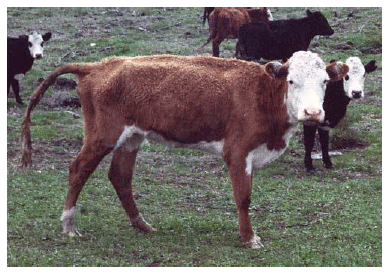
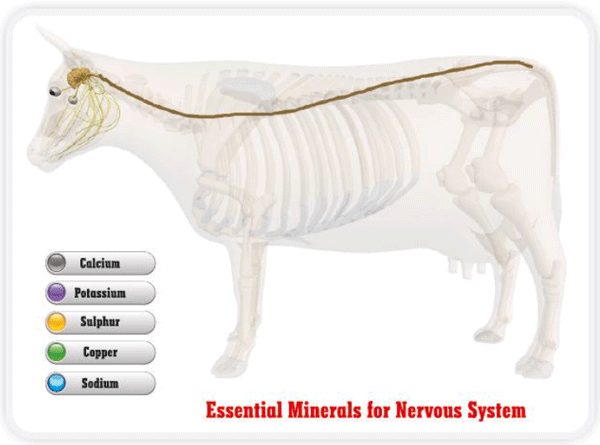
Cobalt:
The word cobalt is derived from the German kobalt, from kobold meaning "goblin", a superstitious term used for the ore of cobalt by miners. Cobalt supplementation was identified during 1930s where erratic cobalt deficiency was noticed in some countries in various names like bush sickness, coast disease, pinning disease, wasting disease and so on which will exhibit as emaciation and death.

Legume fodders are good cobalt source for livestock since nitrogen fixation is required for cobalt inclusion.
Cobalt is one of the most required mineral for ruminants to feed the rumen microbes to synthesize Vitamin B12 (Cobalamine) except which becomes a non-essential for ruminants. Cobalamin is available as adenosyylcobalamin and methycobalamin which are associated with cellular metabolism.
Cobalt deficiency is Vitamin B12 deficiency which will lead to a cascade of conditions initiating as anaemia which will be normocytic and normochromic.
Iron:
From the Anglo-Saxon word "iron" or "iren" (the origin of the symbol Fe comes from the Latin word "ferrum" meaning "iron"). Possibly the word iron is derived from earlier words meaning "holy metal" because it was used to make the swords used in the crusades.
Use of Iron for medicinal purposes dates back to 1500 BC by Indians and Egyptians to treat blood related ailments.

The biggest challenge for iron supplementation is that the amount of Iron ingested will be equal to the amount excreted. Scientists discovered that ascorbic acid can enhance the iron absorption to break the mucosal block theory which prevents Iron utilization. Copper supplementation is also highly essential for utilization of Iron in haemoglobin synthesis. Further vitamin A is having a positive correlation. Iron will be stored in the hepatocytes and used for blood production.
Sources of Iron is mainly from soil. Iron is in abundance in earth’s crust. Though some areas are deficient for iron. The balance & availability of iron is dependent on the chemical form and other metabolites. Fodder like straw, grains, cotton seed meal, fish meal are rich in iron.
Iron supplements becomes more critical for piglets to prevent piglet anaemia. Iron can be supplemented in the form of swabs, chelated powders, pellets, bolus, liquid or injections. Supplementing ferric oxide will not supply iron due to poor bioavailability.
Iron deficiency will lead to anaemia which will be microcytic and hypochromic. Other complications like angular stomatitis, blue sclera, glossitis can also be observed as a result of iron deficiency.
Zinc:
Zinc derived its name from the German term, zink, possibly from zinke, spike since it becomes jagged in the furnace.
Zinc products were used from ancient times for various skin ailments unknowingly. Only during 1950s, the importance of zinc supplementation was realised.
Zinc is available in the soil but is deficient in most of Indian states. The requirement of zinc for plants is much lesser to feed the animals on feeding zinc containing feed which become more essential to supplement externally. Tough Zn content is available in leguminous plants. Chelated zinc can supply a better quantity for absorption.
Zinc is the starter for many enzymatic activities either as a factor to initiate or as a ligand either as a metallo-enzyme or individually including transcription & translation processes of DNA & RNA of all types of cells especially reproductive, epithelial and immune cells (T-cells). Zinc helps in the maintenance of electrolytes.
Zinc is highly essential for the regular functioning of rumen microbes. Keratinization of skin is a co effort by vitamin A and zinc.
Zn deficiency will exhibit as alopecia and parakeratosis and is high with lambs and pigs. It is highly essential in the formation of rods and cones.
Phytic acid binds with zinc and prevents its absorption where it results in the increase of growth rate of broiler chickens which is due to availability of phosphorous, calcium and zinc to be stored in bones and liver.
Zinc can be supplemented by including zinc supplements from zinc sulphate where zinc chelated methionine can supply the animal well.
Manganese:
French manganèse, from Italian manganese, from Medieval Latin magnesia, mineral ingredient of the philosophers' stone (can turn all metals to gold or silver).
Manganese usage in animals was considered essential after 1930s during which prevented perosis in poultry.
Manganese is low in most of the livestock feed and still cattle feeds like bran and cereal fodders will provide good quantity of manganese.
Major deficiency problems include poor development of skeletal matrix, reproductive problems, ataxia and they will be usually sub clinical. In ruminents, skeletal deformities in new born, decreased reproductive performance are seen. In chicks, the symptoms are more prominent in the form of exostosis of tibiometatarsal joints occurs called as perosis. Chondrodystrophy in chickens are also common.
Supplementation of magnesium sulphate given 1 to 4 g/ day is one of the easiest and cheapest treatment for these deficiency conditions which can be given 1 to 4 g/ day.
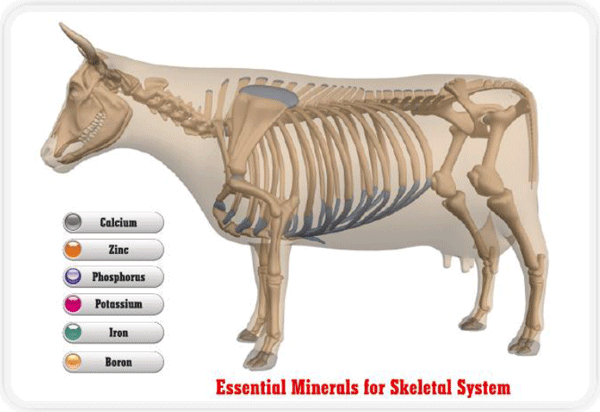
Selenium:
Selenium, the name is derived from the Greek word, selene referring moon/brightness/light. The usage of selenium was identified as essential only after 1957. The requirement range is very narrow and need to be supplemented for only in required quantities. Selenium requirement is highly dependent on the vitamin E and sulphur supplementation/availability since they are inter related.
Selenium is available in a good quantity in feeds like rice, berseem and other leguminous plants and fodder which are growing in selenium rich soil (Punjab, Haryana, U.P and Bihar).
Selenium is highly associated with vitamin E and together they possess a good anti-oxidant property and prevent cells from oxidative degeneration. Selenium is a key constituent of two major enzymes, glutathione peroxidase and iodothyronine 5’-deiodinase which is involved in the conversion of T4 to T3. Apart from this selenium is required for the growth of rumen microbes, protection of leukocytes, prostaglandin & essential fatty acid synthesis, etc.
Defeciency conditions of selenium includes, muscular dystrophy where there will be muscular dystrophy and coagulative necrosis leading to white striations in the muscles which could be either due to selenium or vitamin E or both. Stiff lamb disease where cardiac arrhythmia can be seen in lambs. Selenium is highly essential for reproductive functions which can affect the embryonic growth, Retention of placenta, repeat breeding, cystic ovaries and even can increase the incidence of metritis.
Supplementation can be done with mineral mixtures or fertilizing the soil with selenium.
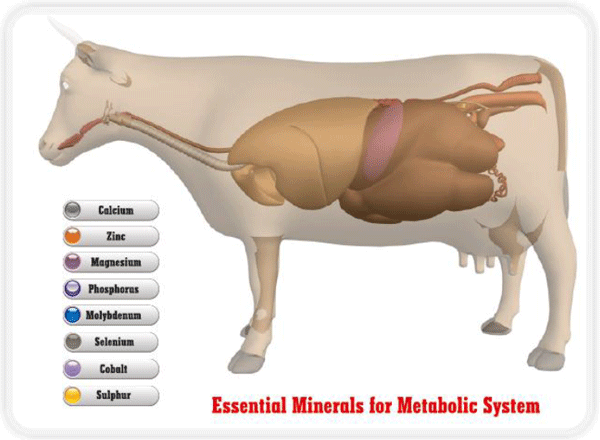
Chromium:
The name is derived from the Greek word chroma used to describe colourful compounds. Chromium is available only in traces in soil and so supplementation through feed becomes essential for livestock.
Chromium is a key component of glucose tolerance factor (GFT) which is effective in improving feed efficiency. Chromium is also associated with insulin action, tends to produce more insulin and increases permeability of insulin for transfer into the cell along with glucose.
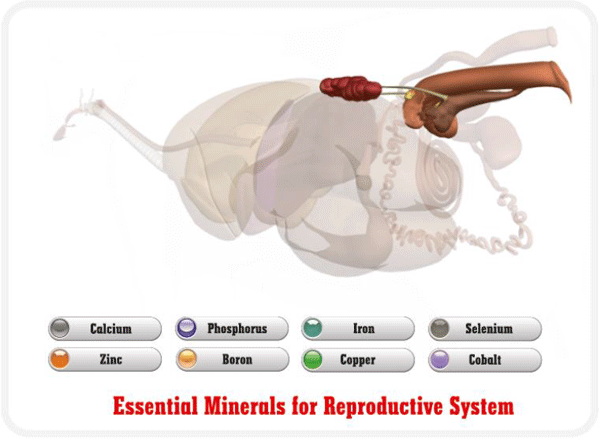
Boron:
Boron is available more in leguminous plants. Boron is essential for regulating the action of parathormone and influences calcium & phosphorous metabolism having a control over bone development. Boron deficiency will lead to osteoporosis and mal utilization of related minerals.
Chelation:
This term is one of the fascinating term when it comes for mineral supplementation. Chelate means crab’s claw in Greek since a mineral is surrounded by a molecule which holds it in a claw like fashion. They are usually natural compounds which will increase or decrease mineral absorption and utilization and so usually chelated minerals have more bioavailalbity than non-chelated minerals especially in chicks and swine. Minerals including magnesium, copper, cobalt, iron, manganese and zinc responded well when used as chelated minerals. One of the key advantage is low concentration of trace minerals can be combined with other organic compounds to feed livestock. Studies had been made with copper and zinc to compart inorganic and chelated mineral forms and significance increase of plasma concentration of mineral that were chelated was found.
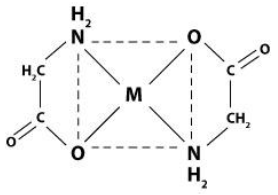
Chelation can be of different types. Metal chelate a metal will be linked with an aminoacid. Eg: Copper lysine, zinc lysine, ferric methionine complexes.
Metal proteinate complex where metal will be linked to a partially hydrolysed protein. Eg; Calcium proteinate, Iron proteinate, copper proteinate complexes.
Metal polysaccharide complex – metal linked with polysaccharides.
The main objectives for using chelates in animal feed nutrients are,
- Reduction of antagonism, interferences and competition among minerals.
- Improve the bioavailability of minerals
- Counteract anti-nutritional factors, which affecting minerals
- Performance improvement
- Health improvement (immune status, functional nutrition)
- over all animal welfare
- Improvement in animal produces quality (meat, milk, egg, wool etc.,)
- Reduce degenerative effect of trace minerals on vitamins in premixes and feed.
- Protect environment by reducing metal pollution.
Mode of action
- Stable in rumen environment & abomasum
- Delivered in small intestine as such.
- Absorbed through active transport (more blood level)
- It act as biological complex (more tissue level)
- Enter into different pool
- Metabolizable in differently
Supplementation:
Various options are available to supplement the livestock with minerals. Supplementation can be injection that delivers a good concentration of the required minerals but is majorly practiced with therapeutic practices. Mineral licks becomes an easier supplementation with farms where salt/mineral licks can provide essential minerals regularly with less man power involvement. Supplementation with powders is a commonly followed supplementation practice for minerals which delivers the required quantity with less technicality which can be easily given regularly.

Conclusion:
Essentiality is not related to the cost of any product, it is the deliverables that speaks. Adding trace minerals either chelated or un-chelated remains essential since their part in all body functions are inevitable. Non supplementation with minerals can hinder with the day to day functioning of enzyme and metabolism. Using minerals that are really required for ruminants and the importance of chelation becomes essential to reduce the chances of occurrence of deficiency conditions in livestock which will be usually unnoticed with trace minerals. It is very difficult to find the deficiency status of trace minerals easily but ensuring its supplementation can prevent deficiency conditions and assures better health and productivity.
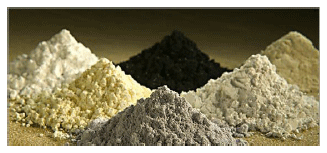
Related topics
Authors:
Join to be able to comment.
Once you join Engormix, you will be able to participate in all content and forums.
* Required information
Would you like to discuss another topic? Create a new post to engage with experts in the community.
Create a post





.jpg&w=3840&q=75)